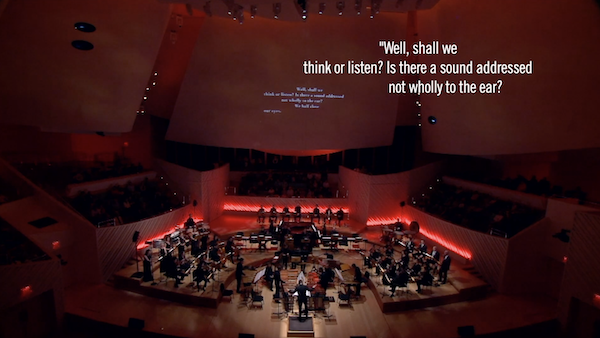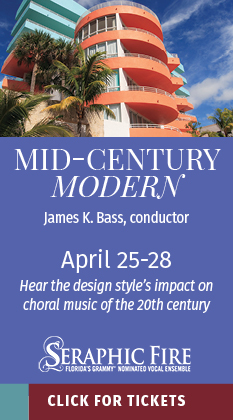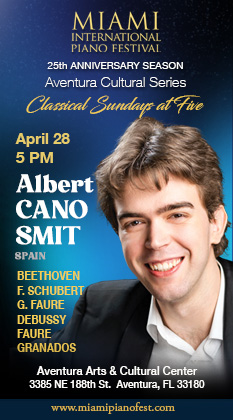Music of Reich and Barber blend varied harmonies in Seraphic Fire program

The music of two of America’s most significant composers formed the program for “In Pursuit of Peace,” Seraphic Fire’s first webcast of 2021, streamed Saturday afternoon. Inner peace and solace are the dominant force behind Samuel Barber’s Hermit Songs while the quest for world peace and harmony are central to Steve Reich’s The Desert Music. Both scores received the high-caliber performances one has come to expect from artistic director Patrick Quigley and his roster of singers.
Hermit Songs marked the beginning of Barber’s collaboration with legendary soprano Leontyne Price who gave the premiere in 1953 with the composer at the piano. He would eventually conceive his opera Antony and Cleopatra and the song-cycle Despite and Still for her. Based on texts by Medieval Irish monks, the ten brief sections of Hermit Songs traverse loneliness, the joy of resounding church bells and the humorous side of monastic life, all couched in Barber’s distinctive melodic idiom.
Three Seraphic Fire singers recorded the songs individually with their accompanists. The films were then assembled into the order of Barber’s cycle. Mezzo-soprano Clara Osowski (whose Haydn program was a highlight of last season’s pre-pandemic Enlightenment Festival) took top honors with four contrasting vignettes. She brought vocal agility and textual clarity to the animated fragments of “At St. Patrick’s Purgatory” and a fine lyric line and beauty of timbre to the austerity of “St. Ita’s Vision.” Osowski summoned power and expressive force for “The Crucifixion” and radiated the solemnity of the monk’s wish for withdrawal from the larger world in “The Desire for Hermitage”, the score’s concluding movement. Casey Rafn was her refined keyboard partner.
Tenor Brad Diamond, a veteran member of the choir, got off to a wavery start in “The Church Bells at Midnight” but his well- schooled light voice rebounded with the wit and fantasy of “The Heavenly Banquet.” His theatrical aplomb and bright tone were perfect for the quirky curves of “The Monk and His Cat.” Pianist John Roberson’s ringing evocation of church bells was particularly effective and he exuded cabaret-like breeziness in the rippling figurations of the cat running around the room.
Soprano Rebecca Myers’ clear high register and nimble coloratura were on full display in the skittering vocal acrobatics of “Sea Snatch” and festive aura of “The Praises of God.” Myers spun “Promiscuity” with winning slyness at the suggestion that a monk will not be sleeping alone. Laura Jean Ward was both sensitive and agile in the piano underpinning.
The Desert Music was a landmark work in Reich’s creative oeuvre. After writing numerous short compositions for his own ensemble, the composer began attempting scores for larger mainstream instrumental and vocal forces. Written in 1983, The Desert Music is one of the first of those works and the 45-minute opus is remarkably assured. While it is obvious that Reich is still feeling his way writing for more conventional orchestral and vocal ensembles, his repetitive minimalism is tempered with sensuous textures and colors. Just when it seems like the music is going off the rails or becoming monotonous, Reich’s writing soars and the combination of voices and instruments skillfully contoured.
Seraphic Fire’s 2016 collaboration with the New World Symphony in Reich’s scaled down chamber version was presented. When this writer covered that concert, I felt that Quigley’s leadership was overly cautious and metronomic. In listening to the performance again, I have revised my opinion. Quigley here is alive to the innumerable changes of meter and dynamics and his blending of the 10-singer vocal contingent with the percussion heavy ensemble was masterful.
Yet the video has its limitations. This was not one of New World’s Wallcast performances so the camera work was totally focused on closeups of Quigley and a distant perspective of the stage. There were no shots of individual players, sections or the vocalists. On the positive side, projections of the moon and sky were given full screen space rather than projections above and around the stage,
Based on the poetry of William Carlos Williams, an inspiration to the beat generation, Reich’s writing spans bustling rhythms, jazzy riffs, pensive emotions and a festive, celebratory fourth movement that suggests New Year’s Eve and the 4th of July combined. At its heart, the initially slow third movement is a call to end the destruction of the arms race, framed with astringent winds and mallet percussion suggesting a toll of doom.
Changing to a more optimistic tone, the words ‘It is a principle of music to repeat the theme” are set to pounding Carl Orff-like patterns, the text’s allusion to the flute and drum mirrored in the inventive instrumental undercurrent. The concluding section brings resolution with an appropriate soft conclusion defining Reich’s vision of communal and humanistic peace.
The high precision, alert playing of the New World Symphony members and the luminous vocals contributed to a fine reading of this ambitious work. Singing with an almost pop-infused sensibility, the female voices were especially beautiful. Perhaps this memorable collaboration can be repeated in the composer’s original scoring for full orchestra and larger chorus in future seasons.
The streaming program “In Pursuit of Peace” will be available for 72 hours. Seraphic Fire presents “Serenade,” a streamed program of love songs for Valentine’s Day, 4 p.m. Sunday, February 14. seraphicfire.org
Posted in Performances
Leave a Comment
Sun Feb 7, 2021
at 12:19 pm
No Comments




